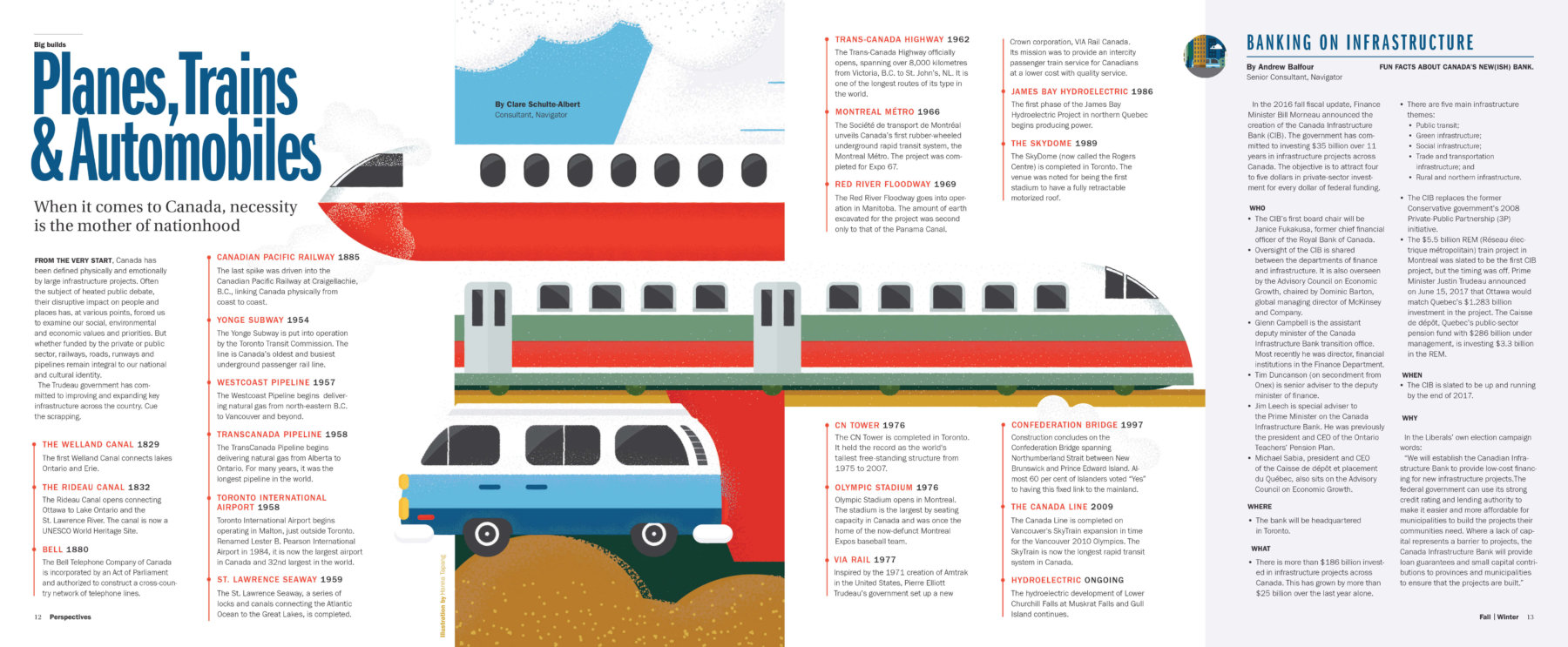- CEOCap
- Jaime Watt’s Debut Bestseller ‘What I Wish I Said’
- Media Training
- The Push Back
- Internship program
- Update Your Profile
- Homepage
- It’s time for a change
- It’s time for a change
- Kio
- Ottawa
- Art at Navigator
- Navigator Limited Ontario Accessibility Policy
- Virtual Retreat 2020 Closing Remarks
- COVID-19 Resources
- Offices
- Navigator Sight: COVID-19 Monitor
- Navigator Sight: COVID-19 Monitor – Archive
- Privacy Policy
- Research Privacy Policy
- Canadian Centre for the Purpose of the Corporation
- Chairman’s desk
- ELXN44
- Media
- Perspectives
- Podcasts
- Subscribe
- Crisis
- Reputation
- Government relations
- Public affairs campaigns
- Capital markets
- Discover
- studio
- How we win
- What we believe
- Who we are
- Careers
- Newsroom
- AI
- Empower by Navigator
- Environmental responsibility

When it comes to Canada, necessity is the mother of nationhood
FROM THE VERY START, Canada has been defined physically and emotionally by large infrastructure projects. Often the subject of heated public debate, their disruptive impact on people and places has, at various points, forced us to examine our social, environmental and economic values and priorities. But whether funded by the private or public sector, railways, roads, runways and pipelines remain integral to our national and cultural identity.
The Trudeau government has committed to improving and expanding key infrastructure across the country. Cue the scrapping.
- THE WELLAND CANAL 1829
The first Welland Canal connects lakes Ontario and Erie. - THE RIDEAU CANAL 1832
The Rideau Canal opens connecting Ottawa to Lake Ontario and the St. Lawrence River. The canal is now a UNESCO World Heritage Site. - BELL 1880
The Bell Telephone Company of Canada is incorporated by an Act of Parliament and authorized to construct a cross-country network of telephone lines. - CANADIAN PACIFIC RAILWAY 1885
The last spike was driven into the Canadian Pacific Railway at Craigellachie, B.C., linking Canada physically from coast to coast. - YONGE SUBWAY 1954
The Yonge Subway is put into operation by the Toronto Transit Commission. The line is Canada’s oldest and busiest underground passenger rail line. - WESTCOAST PIPELINE 1957
The Westcoast Pipeline begins delivering natural gas from north-eastern B.C. to Vancouver and beyond. - TRANSCANADA PIPELINE 1958
The TransCanada Pipeline begins delivering natural gas from Alberta to Ontario. For many years, it was the longest pipeline in the world. - TORONTO INTERNATIONAL AIRPORT 1958
Toronto International Airport begins operating in Malton, just outside Toronto. Renamed Lester B. Pearson International Airport in 1984, it is now the largest airport in Canada and 32nd largest in the world. - ST. LAWRENCE SEAWAY 1959
The St. Lawrence Seaway, a series of locks and canals connecting the Atlantic Ocean to the Great Lakes, is completed. - TRANS-CANADA HIGHWAY 1962
The Trans-Canada Highway officially opens, spanning over 8,000 kilometres from Victoria, B.C. to St. John’s, NL. It is one of the longest routes of its type in the world. - MONTREAL MÉTRO 1966
The Société de transport de Montréal unveils Canada’s first rubber-wheeled underground rapid transit system, the Montreal Métro. The project was completed for Expo 67. - RED RIVER FLOODWAY 1969
The Red River Floodway goes into operation in Manitoba. The amount of earth excavated for the project was second only to that of the Panama Canal. - CN TOWER 1976
The CN Tower is completed in Toronto. It held the record as the world’s tallest free-standing structure from 1975 to 2007. - OLYMPIC STADIUM 1976
Olympic Stadium opens in Montreal. The stadium is the largest by seating capacity in Canada and was once the home of the now-defunct Montreal Expos baseball team. - VIA RAIL 1977
Inspired by the 1971 creation of Amtrak in the United States, Pierre Elliott Trudeau’s government set up a new Crown corporation, VIA Rail Canada. Its mission was to provide an intercity passenger train service for Canadians at a lower cost with quality service. - JAMES BAY HYDROELECTRIC 1986
The first phase of the James Bay Hydroelectric Project in northern Quebec begins producing power. - THE SKYDOME 1989
The SkyDome (now called the Rogers Centre) is completed in Toronto. The venue was noted for being the first stadium to have a fully retractable motorized roof. - CONFEDERATION BRIDGE 1997
Construction concludes on the Confederation Bridge spanning Northumberland Strait between New Brunswick and Prince Edward Island. Almost 60 per cent of Islanders voted “Yes” to having this fixed link to the mainland. - THE CANADA LINE 2009
The Canada Line is completed on Vancouver’s SkyTrain expansion in time for the Vancouver 2010 Olympics. The SkyTrain is now the longest rapid transit system in Canada. - HYDROELECTRIC ONGOING
The hydroelectric development of Lower Churchill Falls at Muskrat Falls and Gull Island continues.
